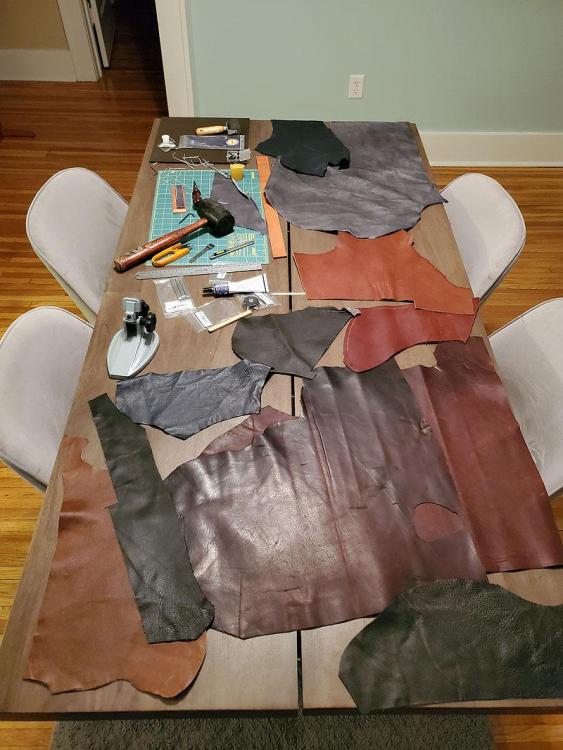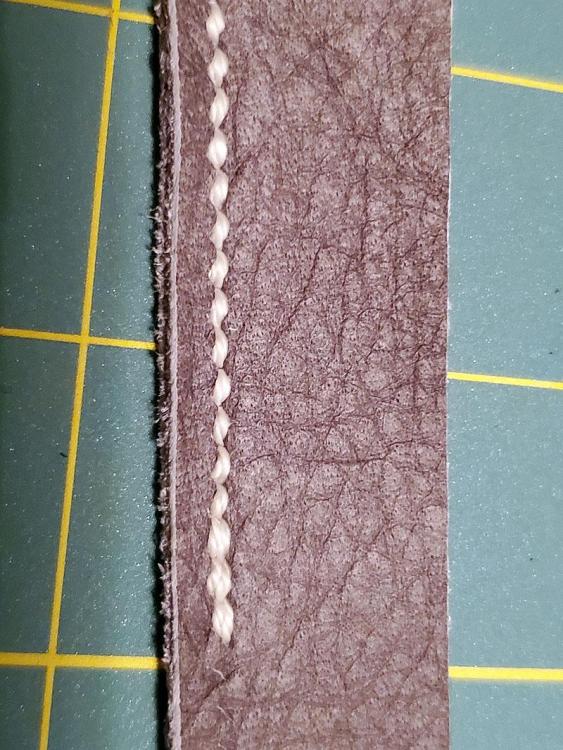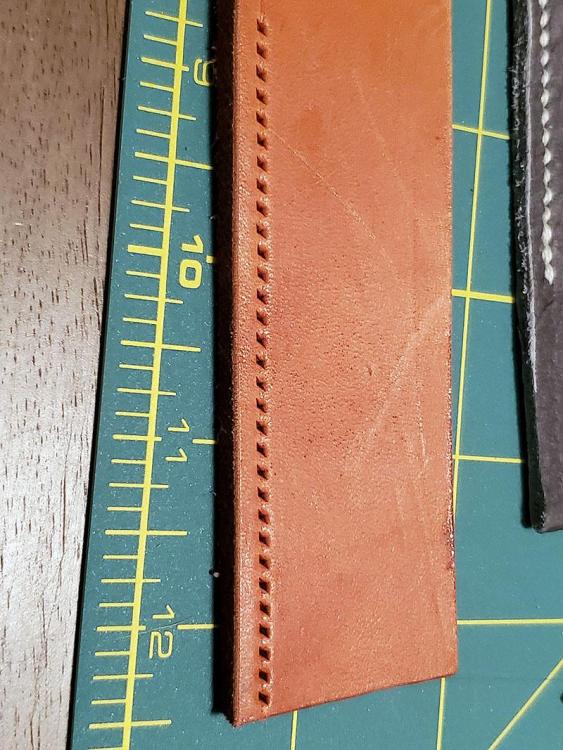
CrankAddict
Members-
Posts
16 -
Joined
-
Last visited
Profile Information
-
Location
USA
-
Interests
Bikes, Woodworking, Watches
CrankAddict's Achievements

Member (2/4)
-
What can a Juki TL actually do?
CrankAddict replied to CrankAddict's topic in Leather Sewing Machines
I feel like your insistence that I'm so angry is a bit of projection. With a servo motor upgrade I believe a 555 is quite similar to an 8700 so it would seem to be worth something. Obviously not to you, but I have non-leather projects planned as well. Surely you won't argue with me that we all need multiple sewing machines, so worst case this 555 will check one of the other boxes and go unused for leather. Your sig lists your 553 for sale, out of curiosity, how much are you asking? -
What can a Juki TL actually do?
CrankAddict replied to CrankAddict's topic in Leather Sewing Machines
Her store sells both. They literally have a 2010q sitting next to a 1541 on the showroom floor. She personally has a 1541 and a 555 at home along with a Janome domestic machine. I went over and talked with her for nearly 2 hours yesterday and I am going to buy her 555 (which their Juki tech converted to a servo motor) for a couple hundred bucks. It's an "I've got nothing to lose" price in my mind so I might as well try it. Surely it can do more than the little Brother PS1000 I have. And I'm fully aware the 555 is a "garment machine" not designed for heavy materials, doesn't have a walking foot, etc. I'll see how far it can take me and if the need arises get a Cobra 26 EPS w/the flatbed add-on and be done with it. The thing I'd push back on regarding your hobby store analogy is that leatherworker.net regularly showcases wallets and watch straps. So discussing a sewing machine to accomplish such things on this forum seems "on brand". If I were looking to marry two pieces of 0.05mm leather to create my own custom line of condoms then I could see the comparison to doll houses. A cabinet maker is nowhere near the "miniature scale" end of the woodworking spectrum. Nor is he able to deal with 6" thick beams. In any case, I'm absolutely not "angry" and have enjoyed the input and conversation from you all. Thank you. -
What can a Juki TL actually do?
CrankAddict replied to CrankAddict's topic in Leather Sewing Machines
But isn't "leather" interchangeable for "wood" in this regard? I can build nice furniture all day long with the tools I have accumulated. The wood is all going to be 2" thick or less and depending on the type of cut I pick from an array of saws to fit the task. But as soon as you show up with 6" x 6" timber beams looking to build a cabin I'm completely stuck. I don't have anything in the shop that can do even a simple crosscut on those monsters. You wouldn't refer to a furniture maker or cabinet maker as "the average man on the street" as if to imply he knows nothing about wood. His projects just utilize a different scale of material. In your examples the first half of the list is of no interest to me whatsoever, whereas wallets, watch straps, European style bags, thin belts are exactly what I'm wanting to do. The talk of a 1" thick leather project sounds as crazy to me as a 1' thick wood project. I'm coming to realize that I found my way into the lumberjack corner of the leatherworking universe so I understand that my target projects are a bit out of sync with the normal stuff around here -
What can a Juki TL actually do?
CrankAddict replied to CrankAddict's topic in Leather Sewing Machines
Thanks Matt, lots of great info in there, I appreciate it! Again, I appreciate the insinuation that I'm stupid enough to think salespeople are 100% forthcoming. But I still cannot find the logic behind a dealer who sells both a small machine and a big machine telling me the small machine can do something it cannot. Why would GM lie about what the 1/2 ton truck can tow when they have a 3/4 and 1 ton they could tell me I need instead? It's not like I gave them a budget, or was on the verge of walking out the door, I was literally asking an open ended question about what I needed... I guess some sales people are as dumb as me! Noted, understood. But THIS is the sort of thing I was trying to get it. Keep in mind my post is titled "what can it actually do?". I.e. I was looking for precisely those types of parameters: X layers of leather of Y type and Z thickness with thread size blah blah blah. Some seem to have read the post as "Why did you guys waste money on these industrial machines when a domestic sewing machine can clearly do it all? And how do I know this? Because the salesperson told me!!" -
What can a Juki TL actually do?
CrankAddict replied to CrankAddict's topic in Leather Sewing Machines
I've spoken to people directly who have used a 2010 to alter leather coats. My friend's wife is a manager at a Juki dealer. The premise that a Juki dealer would lie to me and say that a $999 machine can do something when they could easily try to sell me a machine that costs double just doesn't make any sense. I'd have to believe they prefer less profit and unhappy customers? Here is a video of a sewing machine repair shop doing a teardown and test on a Singer "Heavy Duty", including measuring motor current draw, while sewing as much leather as he could possibly jam under the presser foot. He concludes it is a decent machine. This thing sells for $199. Just makes it hard to understand how the Japanese made "cute" Juki at 5x the cost will burst into flames as soon as I install the leather needle. I see your signature mentions metal and woodworking. Yes, it's nice to have a Mig and a Tig. But you can make a lot of stuff with just a stick welder. Yes, it's nice to have a bandsaw, miter saw, track saw, and table saw. But before I had all that I was able to make some decent items using only a jobsite Dewalt table saw. That seems like the Juki TL class to me. Is it as capable as a Sawstop or Powermatic cabinet saw? Obviously not. But for its class of machine it is well built and with the right setup and blade I can definitely achieve good results. There are many, many posts by beginners and hobbyists on leatherworker.net. I did not realize that the sewing machine subforum was intended for heavy duty, professional level leather workers only (perhaps the name should be "Industrial Leather Sewing Machines")?. After further looking, I do see the sub-forum's description line talks about industrial machines, I had missed that previously. Apologies, I will not post in here again -
What can a Juki TL actually do?
CrankAddict replied to CrankAddict's topic in Leather Sewing Machines
I get that the forum is dedicated to leather sewing machines, but does that imply the sewing machine has to be dedicated to leather? People surely have used this class of higher quality domestic machine to do something with leather. My question was what are the limits? I have no desire to make anything out of 1/4" thick leather. A watch strap starts to get too thick for my tastes at under 3mm. I would have no delusions of being able to sew a heavy duty veg tan project with a smaller machine, but I just find it a bit hard to understand how it could be so unusable as to have never come up in discussion before. In any case, here it is for the archives the next time some idiot like me searches -
When I talk to Juki dealers, their employees rave about personally owning the TL2010Q and TL18QVP (Haruka). They say the 2010 can handle garment leather no problem, and the 18 is even better due to the adjustable height presser foot. I've seen some youtube demos of it buzzing right through thinner leather, so it must be able to do "something" but for all the Juki love around here I do not see either of these models mentioned even one time on this site, ever. Clearly a 1541 or 1508 is a more capable industrial machine, but for a hobbyist making a few bags, wallets, watchstraps, etc for himself, where will these TL machines fall short? I'm so new to sewing in general (and leatherwork for that matter) that I struggle to know what questions to ask or what specs to look at, so I'm hoping one of you might hold my hand a bit Thanks!
-
Hi everyone, I'm very new to all of this and just received a pack of John James 004 blunt needles (L3912). I was quite surprised to see that they are actually ground to a point and feel pretty sharp to the touch. My only other reference is I have a couple of similar size needles from SLC that feel more rounded to the touch. The JJ needles seem like they are definitely sharp enough to snag the thread on a saddle stitch, even if they can't quite by used to pierce leather. Is this normal? Would there be any benefit to doing a few strokes of the tip on some fine sandpaper to make them less sharp? Thanks!
-
Newbie question about chrome vs veg tan
CrankAddict replied to CrankAddict's topic in How Do I Do That?
You definitely bring up some good points there, and yes, my subsequent trip to the leather store did cost me a bit more This time I bought Herman Oak vegtan english bridle by the square foot. That said, it was still "only" $10/sq ft. I think you could easily make 10 watch straps from 1 sq ft. Those watch straps could sell for $60 each even as a no-name business. So $600 of product from $10 of material is on a different scale from woodworking where a $1500 table might have $300 worth of maple in it. Not that any of this matters for a hobbyist like me, but it was just nice to get into a hobby for once that turned out to be a little cheaper than expected versus the other way around haha. Also, on the topic of education, I ordered the Armitage book as a first step. Hopefully that will contain a lot of his wisdom in one resource. -
Newbie question about chrome vs veg tan
CrankAddict replied to CrankAddict's topic in How Do I Do That?
Ok, ok, you convinced me, I just ordered a $10 skiving knife. It looks like Olfa actually makes one (hadn't seen it before) with replaceable blades but it's slightly more expensive than this one so we'll see how this works out. I definitely appreciate all the info. I'll get back to practicing and spend less time over-thinking everything -
Newbie question about chrome vs veg tan
CrankAddict replied to CrankAddict's topic in How Do I Do That?
I really appreciate your detailed reply, you bring up some interesting points to think about. Thank you so much! I definitely agree that I can (and will) make the clam, maul, and maybe some other stuff. And for cutting lengths of leather I would be hard pressed to ever need to upgrade from this little olfa knife with the black blades. The two things that I thought were probably out of my depth to try to make are good chisels/irons (like the KS blade ones) and a good skiving knife. I played around with one of my wood chisels actually and it did a decent job of skiving down the end of some thick veg tan, but I read that you'd want a different bevel angle for leather versus wood to get clean cuts at the right taper. True? I know this isn't a replacement for a skiving machine, like if I need to skive several feet of something, but at this time I'm more focused on skiving the end of a leather watch strap or a watch strap keeper, both of which would be less wide than the blade itself. Is there some box cutter/throwaway blade solution you use for that or is a dedicated skiving knife pretty much a necessity? -
Newbie question about chrome vs veg tan
CrankAddict replied to CrankAddict's topic in How Do I Do That?
Great points. Tools are another area where I'm feeling like I should really spring for the good stuff. I know in the woodshop I've never been satisfied long term with the cheapo option so I'm trying to learn from that experience. The issue is that my local stores don't seem to carry the stuff the internet raves about so I get torn between supporting a local business and buying a premium tool. Also, it's funny you mention the risk of losing a finger... I'm sure it's just a matter of familiarity at this point, but at the moment I'm finding myself far more anxious about cutting my finger with this Olfa razor knife than I am using the miter saw or band saw haha. I have not tried his premium offering, but I have watched countless videos by Nigel, Chartermade, Corter, Mascon and others. That said, the single best video I've found, by far, on saddle stitching was by Peter Nitz. He has a series of videos that you have to pay for, but this one free offering has me strongly considering it even though they're quite expensive. -
Newbie question about chrome vs veg tan
CrankAddict replied to CrankAddict's topic in How Do I Do That?
Thanks for the reply! The thread is pre-waxed, and it clearly sticks to itself on the bobbin. But even so, I pulled the length across a block of beeswax twice before stitching. I did not wax again while stitching, but I only did about a 3 inch run so I didn't think I needed to. Does it really need that much wax or is it something else I'm messing up? -
Newbie question about chrome vs veg tan
CrankAddict replied to CrankAddict's topic in How Do I Do That?
Thanks for the responses! Yeah as I look into the high end watch straps more the materials I'm seeing do seem to be veg tanned (shell cordovan, novonappa, English bridle) Below you can see what $5 of chrome tan scrap gets. Considering what hand made leather items sell for this shocks me, but I'm not complaining! And I do realize the skill and time it takes has a huge impact on price. But as a woodworker I'm just used to material cost being pretty steep. This, on the other hand, feels almost like the material costs are irrelevant. But obviously there are more premium leathers out there... I also attached a picture of my first saddle stitch. The leather is so soft it seems a bit hard to maintain consistency because if you pull too hard it squeezes the leather significantly. But I guess can't expect perfection for stitch number one. I also don't like how the strands of the thread seem to be separating from each other making an individual stitch look like multiple pieces of thread side by side. Is that just a poor thread choice (triple strand waxed nylon) or something I'm doing wrong? I also did get one strip of very thick (5.3mm) veg tan. It edge bevels and creases nicely, but I can't even hammer the chisel through it (I didn't want to risk bending the teeth so I'm not willing to whack it too hard). -
After a few months of watching videos and reading I figured I was ready to step into the real world I stopped into the leather store the other day to pick up some sample leather and some basic tools. My main projects of interest are watch straps and wallets at this point. All of the leather than looked good and felt nice was chrome tan. The veg tan stuff was very rigid and the coloring was natural tan and boring. Of course this is just what they happened to have in the scrap bin at the moment, but I grabbed some chrome tan scraps and headed home. I started out cutting 2 strips of roughly 3 oz leather and gluing them together. This made a very soft and supple strap, but it seems very difficult to work. It's too soft to edge bevel. It's very difficult to make a stitching line with the creaser tool because the side just squishes in. I can't really sand or burnish the edge at all even using a wooden dowel chucked in a drill press (i.e. I know I have enough speed to create heat). So is this just the nature of the beast with chrome tan in general? Or did I just get some "extra soft" chrome tan? I feel like I'm missing some other parameter to describe what I need here. I know about the tanning type and the thickness, but is there some other set of terms to describe the softness? And in general, what type of leather would make the most comfortable watch strap? I hate the rigid, thick uncomfortable straps I've had in the past. As I said, the scraps I got the other day feel great against the skin, but they also feel unlike any watch strap I've ever seen, so there must be a reason for that, right? Thanks! Jeff




